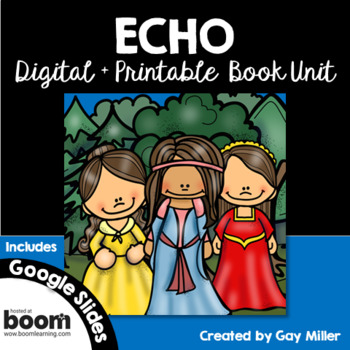ECHO by Pam Munoz Ryan Digital + Printable Novel Study
- PDF
- Google Apps™
- Internet Activities

What educators are saying
Description
Are you hunting for a great novel study for Echo by Pam Muñoz Ryan? Your search ends here! Dive into this all-encompassing unit, seamlessly blending digital and printable resources.
This 5-week unit includes engaging vocabulary activities, comprehension challenges, thought-provoking constructed response writing, and skill-building exercises. Rest easy knowing that each lesson is tailored to the Common Core Standards for grades 5 to 7. Elevate your teaching game with this comprehensive package!
✨ DIGITAL RESOURCES
This novel study includes links to digital resources. Boom Learning is used for multiple-choice, short-answer, and fill-in-the-blank questions such as comprehension questions and vocabulary practice.
Activities that require more open-ended responses may be found in Google Slides. This includes all the writing prompts with organizers for students to plan responses.
✏️PRINTABLE RESOURCES
Vocabulary
- List
- Bookmarks
- Word Cards
- Practice Booklet (24-page booklet)
- 3 Tests
Comprehension and Writing
- 26 Comprehension Checks consisting of multiple choice, fill-in-the-blank, and short-answer
- 34 Constructed Response Writing Questions
Skill Practice
- “Character Trait Booklet”
- Context Clues Organizers and Task Cards
- Analogy Activity, Organizer, and Practice
- Figurative Language Organizers and Response Cards
Essay Writing Unit
- What is an Opinion/Argumentative Essay?
- Selecting a Topic
- Collecting Evidence
- Thesis Statement
- The Introductory Paragraph
- The Essay Structure
- The Body of Your Essay
- The Conclusion Paragraph
- Linking Details
- Proofreading and Editing
- The Final Draft
Essay Writing Craftivity
☆*”˜˜”*°•.¸☆ ★ ☆¸.•°*”˜˜”*°•.¸☆
Boom Cards live in the cloud. They can't be printed. They play on most modern browsers, Android, iPads, iPhones, and Kindle Fires. You open a Boom Learning account to play them (to protect the children). Create Fast Play pins to assign your Boom Cards to students.
Boom Learning also has premium accounts. Premium accounts offer advanced assignment tools, individual and whole class performance tracking, and more. If you are a new Boom Learning customer, when you redeem your Boom Cards purchase you get 90-day free trial of a premium account. When your trial ends, you can renew or move to a free account. You may upgrade, downgrade or cancel at any time. Free accounts use purchased Boom Cards with Fast Play pins.
☆*”˜˜”*°•.¸☆ ★ ☆¸.•°*”˜˜”*°•.¸☆
If you are looking for additional book units, click here to see the complete list of ★available titles





